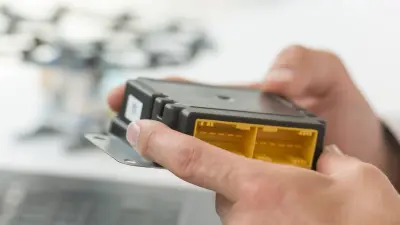Will cars learn to fly like in “Blade Runner 2049”?
Flying taxis and how realistic they are from a technical perspective

In the Hollywood movie “Blade Runner 2049”, people make their way around cities in flying cars. But how realistic are such airborne vehicles and when could this vision of mobility become a reality? Marcus Parentis, expert at Bosch, provides answers.
Blade Runner 2049
Los Angeles, 2049: A dark, overcast sky makes it difficult for the sun to shine through. Instead, garish billboards and flickering holograms submerge the metropolises in a bright, glaring light. Gigantic multi-story buildings rise out of the thick smog. Real and artificially produced people, so-called “replicants,” mostly live together in peace. However, “Blade Runners” like Officer K from the Los Angeles Police Department hunt down replicants that had been declared illegal beacuse of their undefinite lifespan. When on duty, Officer K patrols in a flying car nicknamed a “spinner.”
The spinner is the real star of the film. The flying car can take off and land vertically and mainly flies several hundred meters above the ground. It is propelled by a jet engine at the rear. Officer K uses the spinner both for short distances within Los Angeles and for long journeys to cities like San Diego. However, thanks to its three wheels, the flying car can not only take to the skies but can drive on the ground.

Yes, it’s already technologically possible today. I think we’ll see the first commercially-operated flying taxis from 2023.
Getting around quicker in a flying taxi

Flying over traffic jams and in-between high-rise buildings, according to Marcus Parentis, is likely to be possible in a few years. “The first flying taxis will be available in some cities from 2023,” he predicts. “We’re talking here about so called eVTOL (electric Vertical Take Off and Landing) aircraft.” The first tests with unmanned air taxis were successfully conducted in Dubai in 2017. The metropolis is seen as as a trailblazer. However, European cities like Ingolstadt or Dallas and Los Angeles in USA all want to be forerunners in the futuristic transport service and are testing the first prototypes. However, Parentis feels it is unrealistic that private flying cars will establish themselves in the near future: “At the moment, the trend in the automotive industry and the urban aircraft development sector is heading in the direction of shared mobility,” he explains.
“I dare even say that we will fly autonomously before we drive autonomously as the traffic situation in the air is more orderly than on the roads.”
Like in the film “Blade Runner 2049”, the flying taxis of the future will probably take-off and land vertically. The idea is for them to fly to and fro just below 400 meters above the ground between special platforms in permanent flight corridors. “Initially, human pilots will sit at the joystick, but they will be replaced relatively quickly by autonomous flight systems,” believes Parentis before adding, “I dare even say that we will fly autonomously before we drive autonomously as the traffic situation in the air is more orderly than on the roads. There’s no roadworks up there for example.”
However, who is going to be able to afford it? Parentis is confident: “As soon as the infrastructure is sufficiently in place, passengers can probably travel in flying taxis at prices comparable to those of normal taxi cabs,” he says. For suppliers, it is therefore important to offer reliable technology at a low price. A sensor solution in aviation currently costs tens of thousands of euros, which handed down naturally makes the costs for journeys more expensive. “It’s exactly where we come into play with Bosch’s MEMS sensor box. With this solution, we want to play a part in making air taxi flights affordable for the man on the street,” Marcus Parentis continues.

Electrification lies in the air
In order for flying taxis to be airborne in cities, they have to be as quiet as possible. “It’s why they won’t be propelled by a jet engine, like in the “Blade Runner 2049” movie, but by an electric one,” explains Parentis. The development of such aircraft has only been made possible by the technological advances made in the past ten years, for example in battery and sensor technology, power electronics and through increasing the processing power of processors. In the meantime, large aviation companies like Boeing and Airbus as well as a variety of automotive companies are working on flying taxis. However, startups are also playing an important role. “Since 2017, just under one billion euro has been invested worldwide in the market for flying taxis,” says Parentis.
“Conventional aerospace technology is too expensive, bulky, and heavy to be used in autonomous flying taxis. That is why we have combined dozens of sensors to create a universal control unit.”
Meanwhile his team is in contact with highly promising companies in the startup, automotive and aviation sectors. Bosch is an important partner as a supplier for all these players. The universal control unit combines dozens of micro-electromechanical systems (MEMS) in a small space so air taxis can be located and safely controlled at any time. In addition to acceleration sensors, that measure the movements of the aircraft, built-in yaw-rate sensors detect its angle of attack and magnetic field sensors gauge its compass heading. Pressure sensors determine the altitude via the barometric pressure and the current speed via the dynamic pressure. The built-in MEMS have already proved themselves in the automotive industries. In a few years’ time, they could be a part of the standard equipment used in flying taxis. Perhaps even the dream of a personal aircraft will sometime come true. Like in “Blade Runner 2049,” one could then jump in and simply take off right in front of one’s own doorstep.

Profile

Marcus Parentis, head of the “urban air mobility” team at Bosch
Marcus Parentis trained as an industrial electronics technician, graduated as a computer engineer and has been involved in the development of multi-helicopter systems since 2004. As early as 2015, he has been the central port of call for this topic at Bosch. In the following year, he founded his first internal startup which offered multi-helicopter solutions as a service in the safety technology sector. Since 2017, Marcus Parentis has been involved in flying taxis, which originated in the Home of Innovation and Start-up department. The team now consists of 15 members worldwide and supports the company in the urban air mobility sector.
Summary
Science fiction? No, science fact. Flying cars like in “Blade Runner 2049” are already technically possible today. The first flying taxis are due to take off in 2023 and fly to and fro from pre-defined take-off and landing hubs.


